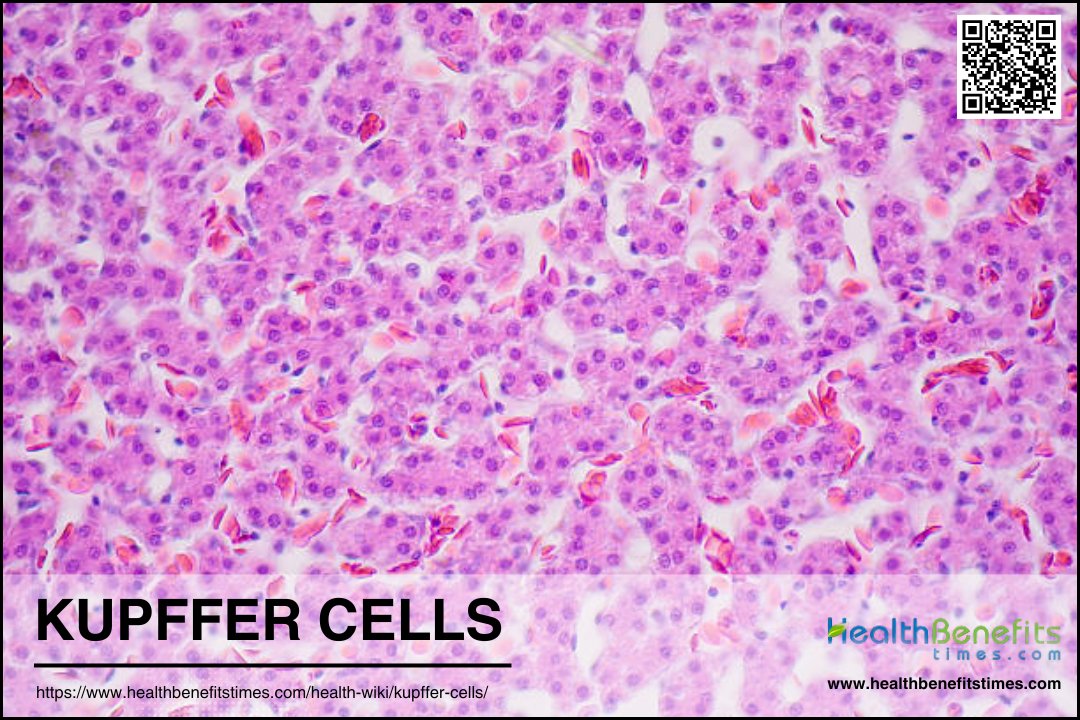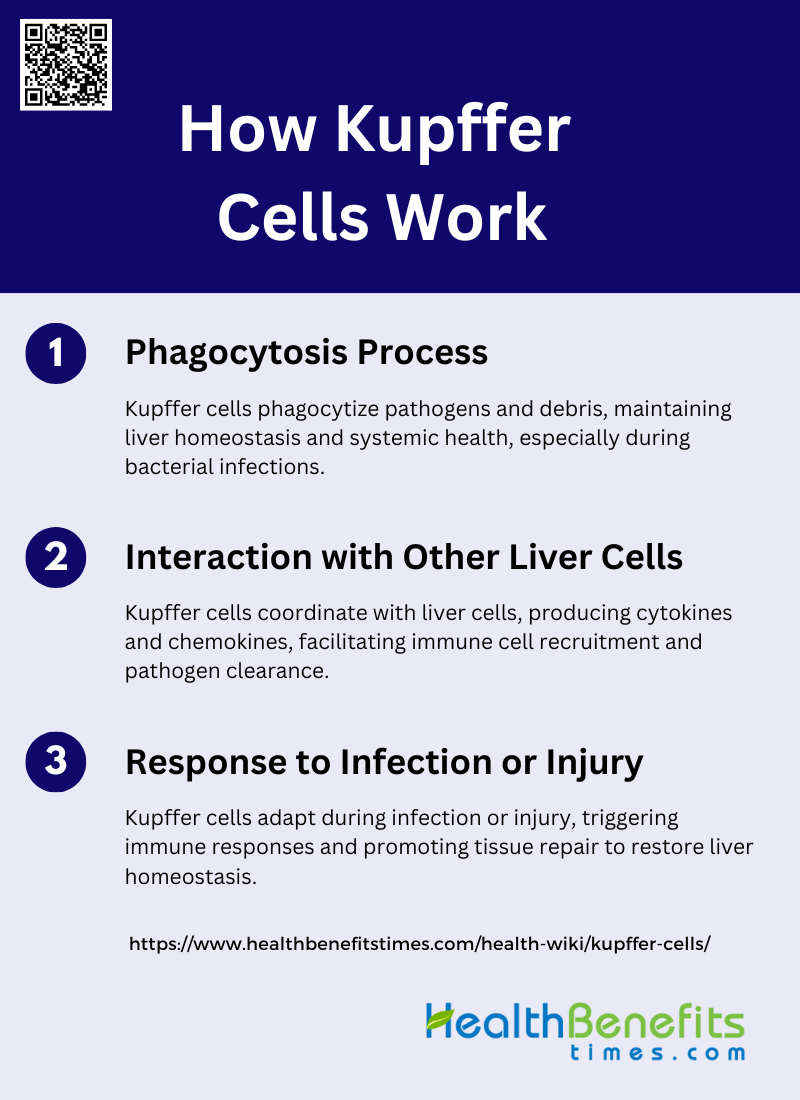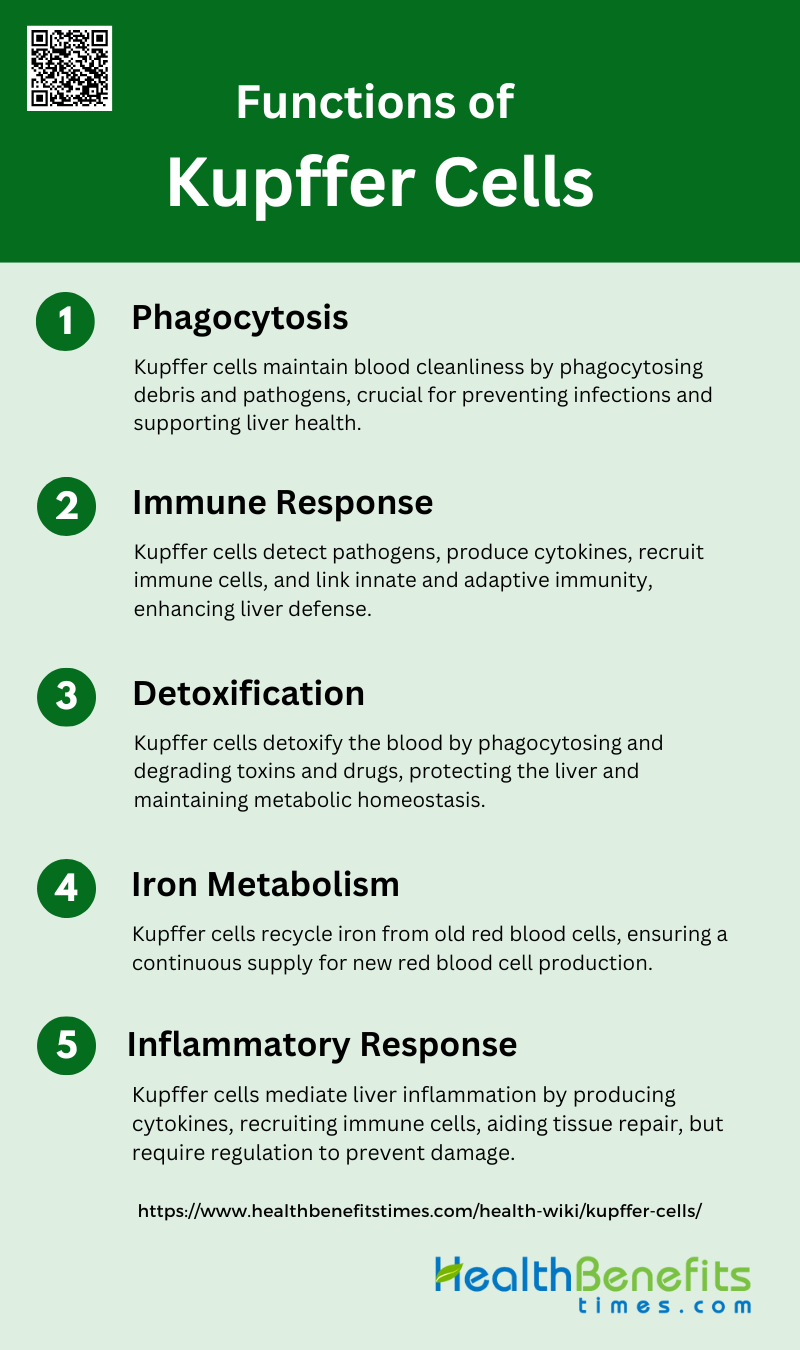Kupffer cells are specialized macrophages located in the liver, forming a crucial component of the body’s immune system. They are the largest population of tissue-resident macrophages and play a vital role in maintaining immune balance within the liver. Kupffer cells are primarily involved in phagocytosing pathogens and debris, presenting antigens, and orchestrating immune responses. They are pivotal in the pathogenesis of liver diseases such as non-alcoholic fatty liver disease (NAFLD) and non-alcoholic steatohepatitis (NASH), where they can either exacerbate or mitigate disease progression through their interactions with other liver cells. Additionally, Kupffer cells are involved in the liver’s response to ischemia/reperfusion injury and can exhibit both pro-inflammatory and anti-inflammatory phenotypes depending on the stimuli they encounter. Their ability to modulate immune responses makes them a potential target for therapeutic interventions in liver-related diseases.
The Origin and Development of Kupffer Cells
Explanation of Mononuclear Phagocyte System
The mononuclear phagocyte system (MPS) is a network of cells that includes monocytes, macrophages, and dendritic cells, which play crucial roles in maintaining tissue homeostasis and immune defense. Monocytes develop in the bone marrow and circulate in the blood, where they can migrate into tissues and differentiate into macrophages or dendritic cells. These cells are essential for both innate and adaptive immunity, as they can present antigens to T cells and initiate immune responses. The MPS is involved in various physiological processes, including inflammation, tissue repair, and pathogen clearance, making it a critical component of the immune system.
How Kupffer Cells Originate from Bone Marrow-Derived Monocytes
Kupffer cells, the resident macrophages of the liver, can originate from bone marrow-derived monocytes. Studies have shown that bone marrow cells labeled with specific dyes can migrate to the liver and differentiate into Kupffer cells. These monocytes express macrophage-specific antigens shortly after entering the liver and gradually adopt the characteristics of Kupffer cells, including phagocytic activity and specific surface markers. This process indicates that bone marrow-derived monocytes can replenish the Kupffer cell population, especially under conditions where the existing Kupffer cells are depleted or during liver injury.
Differentiation Process into Kupffer Cells
The differentiation of bone marrow-derived monocytes into Kupffer cells involves several stages. Initially, monocytes migrate from the bloodstream into the liver, where they encounter the hepatic microenvironment. This environment, influenced by factors secreted by hepatocytes, promotes the expression of specific surface markers and functional properties characteristic of Kupffer cells. Over time, these monocytes adopt the transcriptional and phenotypic profiles of resident Kupffer cells, becoming long-lived and self-renewing. This process is crucial for maintaining the Kupffer cell population, particularly during liver growth or after injury, ensuring the liver’s ability to perform its immune and homeostatic functions.
How Kupffer Cells Work
Kupffer cells are specialized macrophages located in the liver, playing a vital role in immune surveillance and homeostasis. They are involved in various processes such as phagocytosis, interaction with other liver cells, and response to infection or injury. Below is a detailed examination of these processes:
1. Phagocytosis Process
Kupffer cells, the liver-resident macrophages, play a crucial role in the phagocytosis of pathogens and debris. They are strategically located in the liver sinusoids, making them the first line of defense against blood-borne pathogens. Kupffer cells exhibit vigorous phagocytic activity, ingesting and eliminating bacteria, dead cells, and other particulate matter from the bloodstream. During systemic bacterial infections, Kupffer cells interact with neutrophils to enhance the phagocytic process, ensuring efficient clearance of pathogens. However, their phagocytic function can be compromised under certain conditions, such as after liver transplantation, where it deteriorates before showing improvement. This phagocytic activity is essential for maintaining liver and systemic homeostasis.
2. Interaction with Other Liver Cells
Kupffer cells interact closely with other liver cells, including hepatocytes and sinusoidal endothelial cells (LSECs), to maintain liver homeostasis and immune surveillance. They produce cytokines and chemokines, such as CXCL10, which facilitate the recruitment and activation of immune cells like T cells, NK cells, and monocytes. Kupffer cells also serve as adhesion hubs for CD8 T cells, promoting their interaction with infected hepatocytes and aiding in the elimination of pathogens. Additionally, Kupffer cells’ interactions with LSECs are crucial for regulating sinusoidal vascular permeability and immune cell migration. These interactions are vital for orchestrating a coordinated immune response and ensuring effective pathogen clearance and tissue repair.
3. Response to Infection or Injury
In response to infection or injury, Kupffer cells undergo significant changes to orchestrate an effective immune response. For instance, during bacterial infections, Kupffer cells can undergo necroptosis, a form of programmed cell death, which triggers the recruitment of monocytes and the initiation of a type 1 inflammatory response. This is followed by a type 2 response involving hepatocyte-derived IL-33 and basophil-derived IL-4, leading to the alternative activation of monocyte-derived macrophages and restoration of liver homeostasis. Kupffer cells also produce IL-12 and other cytokines that activate NK cells and T cells, enhancing their cytotoxicity against infected cells and tumors. These dynamic responses highlight the critical role of Kupffer cells in managing liver inflammation and promoting tissue repair.
Functions of Kupffer Cells
Kupffer cells are specialized macrophages located in the liver, playing a vital role in immune surveillance and homeostasis. They are involved in various processes such as phagocytosis, interaction with other liver cells, and response to infection or injury. Below is a detailed examination of these processes:
1. Phagocytosis
Kupffer cells, the resident macrophages of the liver, play a crucial role in maintaining blood cleanliness by phagocytosing debris and pathogens. These cells are strategically located in the liver sinusoids, where they can efficiently capture and digest bacteria, dead cells, and other particulate matter from the blood. This phagocytic activity is essential for preventing infections and maintaining overall liver health. By engulfing and breaking down these unwanted materials, Kupffer cells help to detoxify the blood and support the immune system in its defense against pathogens.
2. Immune Response
Kupffer cells are integral to the liver’s immune response, acting as the first line of defense against infections. They detect and respond to pathogens by producing cytokines and chemokines, which recruit other immune cells to the site of infection. This activity not only helps to contain and eliminate pathogens but also initiates a broader immune response. Kupffer cells can present antigens to T cells, thereby linking innate and adaptive immunity. Their ability to sense and react to microbial invaders makes them key players in the liver’s immune surveillance and response mechanisms.
3. Detoxification
Kupffer cells contribute significantly to the liver’s detoxification processes. They are involved in the breakdown and clearance of various toxins and drugs from the bloodstream. By phagocytosing and degrading these harmful substances, Kupffer cells help to protect the liver and the body from potential damage. This detoxification role is crucial for maintaining metabolic homeostasis and preventing the accumulation of toxic compounds. The ability of Kupffer cells to process and eliminate these substances underscores their importance in liver function and overall health.
4. Iron Metabolism
Kupffer cells play a vital role in iron metabolism by recycling iron from senescent red blood cells. They phagocytose old red blood cells and break them down, releasing iron in the form of ferritin, which can then be utilized by the body for erythropoiesis. This process ensures a continuous supply of iron, which is essential for the production of new red blood cells. The efficient recycling of iron by Kupffer cells helps to maintain iron homeostasis and supports the body’s overall metabolic needs.
5. Inflammatory Response
Kupffer cells are key mediators of the liver’s inflammatory response. They produce and release various inflammatory cytokines and chemokines in response to liver injury or infection. This activity helps to recruit other immune cells to the site of inflammation, facilitating tissue repair and defense against pathogens. However, excessive or chronic activation of Kupffer cells can contribute to liver diseases such as hepatitis, fibrosis, and cirrhosis. Thus, while their role in inflammation is crucial for immediate defense and repair, it must be tightly regulated to prevent long-term damage.
Kupffer Cells in Liver Health and Disease
Role in Maintaining Liver Homeostasis
Kupffer cells (KCs) are essential for maintaining liver homeostasis by performing various functions such as phagocytosis of apoptotic cells and gut-derived foreign particles, thus preventing excessive inflammation. They reside in liver sinusoids and are shaped by the micro-environment to exhibit unique immunosuppressive features. KCs also engage in specialized activities like iron scavenging and uptake of opsonized particles from portal blood, contributing to the liver’s metabolic functions6. By maintaining a balance between pro-inflammatory and anti-inflammatory responses, KCs play a crucial role in preserving liver and overall body homeostasis.
Kupffer Cells in Liver Diseases
Kupffer cells are implicated in the pathogenesis of various liver diseases, including non-alcoholic fatty liver disease (NAFLD), hepatitis, and liver fibrosis. In NAFLD, KCs contribute to disease progression by mediating inflammation through pathways like JNK and NF-κB. During hepatitis B and C infections, KCs play a dual role by maintaining homeostasis and contributing to liver pathology through the regulation of anti-viral immunity. In conditions like non-alcoholic steatohepatitis (NASH), KCs derived from monocytes exhibit a pro-inflammatory status, exacerbating liver damage. Overall, KCs are central to both the progression and resolution of liver diseases.
Potential Negative Effects When Kupffer Cell Activity is Dysregulated
Dysregulated activity of Kupffer cells can lead to detrimental effects on liver health. When over-activated, KCs release inflammatory mediators, growth factors, and reactive oxygen species, contributing to acute hepatocyte injury and chronic liver conditions such as fibrosis and cancer3. In the context of chronic ethanol consumption, KC activation exacerbates liver damage, potentially leading to hepatic carcinogenesis. Additionally, during NASH, impaired KC self-renewal and the presence of immature, pro-inflammatory monocyte-derived KCs can worsen liver damage and disrupt lipid metabolism. Thus, dysregulated KC activity is a significant factor in the pathogenesis of various liver diseases.
FAQs
1. What are the differences between Kupffer cells and other liver macrophages?
Kupffer cells are liver-resident macrophages that originate from yolk sac-derived progenitors and are distinct from other liver macrophages, which typically originate from bone marrow-derived monocytes. Kupffer cells are self-renewing and long-lived, while other macrophages in the liver may be more transient and recruited in response to injury or infection.
2. How do Kupffer cells contribute to the liver’s tolerance to gut-derived antigens?
Kupffer cells play a critical role in the liver’s immune tolerance by phagocytosing and processing gut-derived antigens without triggering a strong inflammatory response. This helps prevent excessive immune activation and inflammation in response to the constant exposure to antigens from the gut.
3. Can Kupffer cells influence liver regeneration?
Yes, Kupffer cells are involved in liver regeneration by releasing cytokines and growth factors that promote hepatocyte proliferation and tissue repair following liver injury or partial hepatectomy.
4. What is the role of Kupffer cells in the liver’s response to toxins and drugs?
Kupffer cells are responsible for detecting and removing toxins, drugs, and other harmful substances from the bloodstream. They can also release cytokines that modulate the liver’s response to these substances, influencing detoxification processes and potentially contributing to drug-induced liver injury.
5. Do Kupffer cells have a role in the development of liver fibrosis?
Yes, Kupffer cells can contribute to the development of liver fibrosis by releasing pro-inflammatory cytokines and activating hepatic stellate cells, which are the main collagen-producing cells in the liver. Chronic activation of Kupffer cells is a key factor in the progression of liver fibrosis.
6. How do Kupffer cells interact with the gut microbiota?
Kupffer cells interact with gut microbiota by phagocytosing microbial products that enter the liver via the portal vein. They help maintain a balance between tolerance and immune activation, which is crucial for preventing liver inflammation and disease.
7. Are there any known markers for identifying Kupffer cells?
Kupffer cells can be identified by specific markers such as F4/80, CD68, and CLEC4F. These markers distinguish Kupffer cells from other liver macrophages and help in studying their function and behavior in various conditions.
8. How do Kupffer cells affect liver metabolism?
Kupffer cells influence liver metabolism by modulating lipid and glucose metabolism through the release of cytokines and other signaling molecules. Dysregulation of Kupffer cell activity can contribute to metabolic diseases such as NAFLD.
9. Can Kupffer cells be targeted for therapeutic purposes?
Yes, Kupffer cells are potential therapeutic targets in liver diseases. Modulating their activity, either by inhibiting pro-inflammatory responses or enhancing their anti-inflammatory functions, could be a strategy to treat conditions like NAFLD, NASH, and liver fibrosis.
10. How does aging affect Kupffer cells?
Aging can alter Kupffer cell function, leading to changes in their phagocytic activity, cytokine production, and ability to maintain immune tolerance. These changes may contribute to an increased susceptibility to liver diseases in older individuals.




